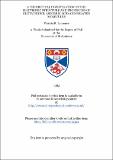Files in this item
A theoretical investigation of the electronic structure and properties of glutathione, ascorbic acid and related molecules
Item metadata
| dc.contributor.author | Laurence, Patricia R. | |
| dc.coverage.spatial | 204 p. | en_US |
| dc.date.accessioned | 2018-07-16T15:45:08Z | |
| dc.date.available | 2018-07-16T15:45:08Z | |
| dc.date.issued | 1982 | |
| dc.identifier.uri | https://hdl.handle.net/10023/15444 | |
| dc.description.abstract | The methods of molecular quantum mechanics have been used to study the important biological molecules glutathione, ascorbic acid and related compounds. The preferred conformations of glutathione, its constituent amino acids and their residues have been investigated using the semi-empirical PCILO procedure. Comparisons with ab initio calculations are given for the smaller molecules. The electronic structure and properties of ascorbic acid and its metabolites have been studied using ab initio procedures. The calculations include geometry optimizations, electrostatic molecular potential maps, spin density calculations on the radical species and investigations of charge transfer interactions and of metal complexing. | en_US |
| dc.language.iso | en | en_US |
| dc.publisher | University of St Andrews | |
| dc.subject.lcc | QD462.L2 | |
| dc.title | A theoretical investigation of the electronic structure and properties of glutathione, ascorbic acid and related molecules | en_US |
| dc.type | Thesis | en_US |
| dc.type.qualificationlevel | Doctoral | en_US |
| dc.type.qualificationname | PhD Doctor of Philosophy | en_US |
| dc.publisher.institution | The University of St Andrews | en_US |
This item appears in the following Collection(s)
Items in the St Andrews Research Repository are protected by copyright, with all rights reserved, unless otherwise indicated.

